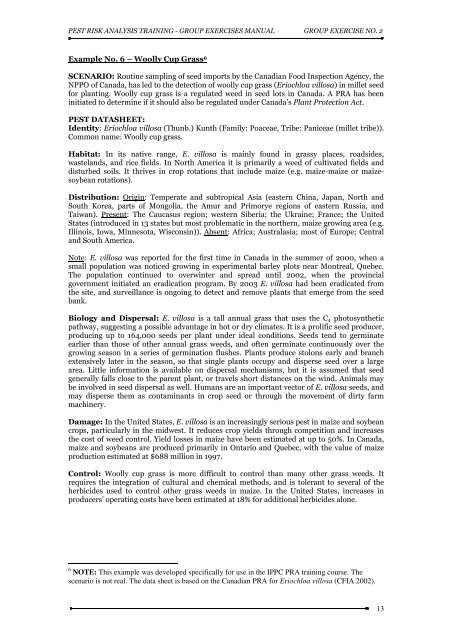PEST RISK ANALYSIS (PRA) TRAINING Group Exercises Manual
PEST RISK ANALYSIS (PRA) TRAINING Group Exercises Manual
PEST RISK ANALYSIS (PRA) TRAINING Group Exercises Manual
Create successful ePaper yourself
Turn your PDF publications into a flip-book with our unique Google optimized e-Paper software.
<strong>PEST</strong> <strong>RISK</strong> <strong>ANALYSIS</strong> <strong>TRAINING</strong> - GROUP EXERCISES MANUAL GROUP EXERCISE NO. 2<br />
Example No. 6 – Woolly Cup Grass 6<br />
SCENARIO: Routine sampling of seed imports by the Canadian Food Inspection Agency, the<br />
NPPO of Canada, has led to the detection of woolly cup grass (Eriochloa villosa) in millet seed<br />
for planting. Woolly cup grass is a regulated weed in seed lots in Canada. A <strong>PRA</strong> has been<br />
initiated to determine if it should also be regulated under Canada’s Plant Protection Act.<br />
<strong>PEST</strong> DATASHEET:<br />
Identity: Eriochloa villosa (Thunb.) Kunth (Family: Poaceae, Tribe: Paniceae (millet tribe)).<br />
Common name: Woolly cup grass.<br />
Habitat: In its native range, E. villosa is mainly found in grassy places, roadsides,<br />
wastelands, and rice fields. In North America it is primarily a weed of cultivated fields and<br />
disturbed soils. It thrives in crop rotations that include maize (e.g. maize-maize or maizesoybean<br />
rotations).<br />
Distribution: Origin: Temperate and subtropical Asia (eastern China, Japan, North and<br />
South Korea, parts of Mongolia, the Amur and Primorye regions of eastern Russia, and<br />
Taiwan). Present: The Caucasus region; western Siberia; the Ukraine; France; the United<br />
States (introduced in 13 states but most problematic in the northern, maize growing area (e.g.<br />
Illinois, Iowa, Minnesota, Wisconsin)). Absent: Africa; Australasia; most of Europe; Central<br />
and South America.<br />
Note: E. villosa was reported for the first time in Canada in the summer of 2000, when a<br />
small population was noticed growing in experimental barley plots near Montreal, Quebec.<br />
The population continued to overwinter and spread until 2002, when the provincial<br />
government initiated an eradication program. By 2003 E. villosa had been eradicated from<br />
the site, and surveillance is ongoing to detect and remove plants that emerge from the seed<br />
bank.<br />
Biology and Dispersal: E. villosa is a tall annual grass that uses the C 4 photosynthetic<br />
pathway, suggesting a possible advantage in hot or dry climates. It is a prolific seed producer,<br />
producing up to 164,000 seeds per plant under ideal conditions. Seeds tend to germinate<br />
earlier than those of other annual grass weeds, and often germinate continuously over the<br />
growing season in a series of germination flushes. Plants produce stolons early and branch<br />
extensively later in the season, so that single plants occupy and disperse seed over a large<br />
area. Little information is available on dispersal mechanisms, but it is assumed that seed<br />
generally falls close to the parent plant, or travels short distances on the wind. Animals may<br />
be involved in seed dispersal as well. Humans are an important vector of E. villosa seeds, and<br />
may disperse them as contaminants in crop seed or through the movement of dirty farm<br />
machinery.<br />
Damage: In the United States, E. villosa is an increasingly serious pest in maize and soybean<br />
crops, particularly in the midwest. It reduces crop yields through competition and increases<br />
the cost of weed control. Yield losses in maize have been estimated at up to 50%. In Canada,<br />
maize and soybeans are produced primarily in Ontario and Quebec, with the value of maize<br />
production estimated at $688 million in 1997.<br />
Control: Woolly cup grass is more difficult to control than many other grass weeds. It<br />
requires the integration of cultural and chemical methods, and is tolerant to several of the<br />
herbicides used to control other grass weeds in maize. In the United States, increases in<br />
producers’ operating costs have been estimated at 18% for additional herbicides alone.<br />
6 NOTE: This example was developed specifically for use in the IPPC <strong>PRA</strong> training course. The<br />
scenario is not real. The data sheet is based on the Canadian <strong>PRA</strong> for Eriochloa villosa (CFIA 2002).<br />
13













